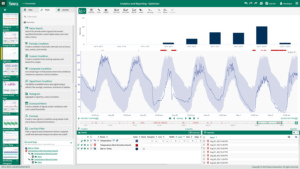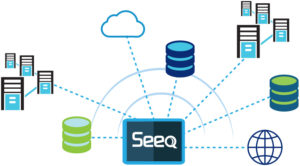
SCADA’s emerging role in digital transformation initiatives
Mike Edwards
Features analytics IIoT SCADA Seeq
Data from SCADA systems can be used by advanced analytics to rapidly surface insights, enabling decisions to improve production outcomes.
By Michael Risse
Supervisory control and data acquisition (SCADA) systems have been mainstays of process manufacturing for at least 30 years. These systems have been reliably monitoring, gathering, processing and presenting operational data for decades without a lot of fanfare.
Now, as data volumes explode due to wireless sensors and cheaper data collection and storage, SCADA has an opportunity to play an increasingly important role. That’s good news, because manufacturers are not about to throw away systems they already paid for that do what they’re supposed to do.
The challenge for many companies is creating value from existing and new sources of data, with traditional tools such as spreadsheets falling short. New approaches are needed, ones centered on advanced analytics software designed for use by process engineers and other subject matter experts.
Bringing Together Enterprise Data, From Sensors to IT
A number of factors are driving a data tsunami, in particular the increase in sensor data from Industrial Internet of Things (IIoT) initiatives, and IT/OT (information technology/operations technology) convergence to enable corporate digital transformation objectives. SCADA can and should take its place as a source of IIoT data, facilitating the merging of the IT and OT worlds.
IT/OT convergence is driving SCADA growth in the wastewater industry, for example, according to ARC Advisory Group, as companies increasingly contextualize data from SCADA systems with enterprise information systems to inform decisions. “Today’s systems and components are highly compatible and even interchangeable, giving utilities a wide variety of choices and opportunities for customization as SCADA becomes more modular. SCADA systems are also becoming increasingly ubiquitous, as thin clients, web portals, and web-based products are gaining popularity with most major vendors,” write the ARC report authors.
As a complement to IIoT, information from SCADA systems will be more important than ever to drive better business decisions, optimize operations and enable greater agility, but only if used in conjunction with today’s sophisticated advanced analytics software to create insights.
Lower Costs Drive SCADA System Data Growth
In one form or another, manufacturers have been collecting, storing and analyzing process data from the earliest days of the industrial revolution. But with the rise of IIoT, better networking technologies and improved data storage options, every stage of the data lifecycle has gotten cheaper over the last two decades by an order of magnitude, if not two. These stages include data generation at the sensor, connectivity and data storage.
So, if once only the most critical assets were worth monitoring via SCADA in the past, over time less critical but still important assets began to be included either in the plant network or through a complementary IIoT platform, in particular formerly disconnected or standalone assets.
This change therefore is not in architecture, except perhaps for wireless connectivity replacing wired, but in the economics. And the economics have absolutely changed and are the principal driver behind a host of industry trends such as big data, IoT, wireless networking and cloud data services. Computing is so cheap that customers can justify generating, collecting and storing ever more data, driving the convergence – some might say “collision”—of the OT/IT worlds.
Advanced Analytics Accelerate Insights
In the face of exploding data volumes, the spreadsheet has been and still is the most commonly used analytics tool for SCADA users. Most SCADA system connect in one way or another to spreadsheets for data cleansing, contextualization, calculations and modeling.
In many cases, this connection is quite crude and requires manual export of data from the SCADA system to a spreadsheet. This is time-consuming, inefficient and restricts analysis to a single user.
Once the data is imported, more problem arise as spreadsheets are a general-purpose tool not designed for data analysis. Users must spend inordinate amounts of time and expend extraordinary efforts to generate results, and some problems are simply too complex to solve.
Due to these and other issues, there is increasing interest and demand for improved analytics offerings — descriptive, predictive, diagnostic, interactive and prescriptive — which go well beyond the scope of spreadsheets. These improvements are being delivered via what many now refer to as advanced analytics (Figure 1).
Specifically, advanced analytics speak to the inclusion of cognitive computing technologies into analytics applications. The introduction of machine learning and other analytics techniques accelerates an engineer’s efforts when seeking correlations, clustering or any other needle- within-the-haystack search for process data. With these features, engineers gain an order-of-magnitude improvement in analytics capabilities, akin to moving from pen and paper to the spreadsheet, as shown in the following examples.
Better Visibility into Oil Well Performance
Consider engineers struggling with the difficult, time-consuming task of tracking the performance of oil wells. Analyzing well performance is challenging on a daily basis due to disparate, non-integrated data sources.
Advanced analytics software enables engineers to integrate data from a number of disparate data sources, including SCADA systems, and to view this data in one interface (Figure 2). The result is engineers can quickly and easily analyze the data and draw better, quicker conclusions. The software might also include the capability to build a custom asset structure. This can be very useful for quickly comparing the performance of various wells, and for scaling out calculations and analyses.
Advanced analytic software enables faster focus on operating problems, leading to better production, lower energy and chemical costs, improved safety and lower emissions. In the long run, this also results in reduced maintenance costs and improved reliability. It lessens the burden of data wrangling, allowing engineers to spend their valuable time on more productive activities such as analysis.
Predictive Analytics Heads Off Sewage Spills
A water utility was experiencing sewage spills, at great cost to the environment and to its reputation. Following a sewer spill at an environmentally significant site, the utility needed to find a way to reduce the likelihood and impact of future spill events.
The utility leveraged predictive analytics to develop an online sewer blockage detection system (Figure 3). The analytical model is able to detect a partial blockage event 13 hours ahead of current methods, giving the utility plenty of time to act and prevent a spill. This prediction is done by engineers using advanced analytics software to realize quick insights to historical data from SCADA systems, a major improvement that is now being used to protect the environment by preventing sewage spills.
Essential Elements of Advanced Analytics
An advanced analytics application should include two critical components.
First, it should be a self-service offering for the engineers who have the required experience, expertise and history with the plant and processes. This enables engineers to work at an application level with productivity, empowerment, interaction and ease-of-use benefits.
Second, the advanced analytics solution should include a connection between the analysis that is created and the underlying data set so users can simply click through and get to the underlying data. Advanced analytics offerings should be used to produce not just pictures of data in visualizations, but to also provide access to the analytics and sources that generated the outputs. Engineers, teams, managers and organizations can therefore use these new capabilities to enable the distribution of benefits throughout a plant and a company.
IIoT envisions sensored, connected, integrated processes providing increased and consistent visibility, accuracy and data-driven insights on production results. This can now be accomplished with advanced analytics, elevating the importance of SCADA systems.
Michael Risse is the CMO and Vice President at Seeq Corporation, a company building innovative productivity applications for engineers and analysts that accelerate insights into industrial process data.
Print this page


